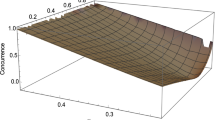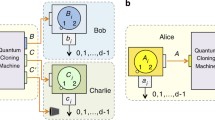Abstract
We discussed the distribution and generation of quantum correlations in a universal covariant quantum cloning circuit. Specifically, we first considered the distribution of quantum correlation, i.e., quantum discord, among the four qubits of the circuit. Then, we analyzed the generation of genuine 3- or 4-qubit entanglement in the cloning process. It is found that the circuit generates genuine 4-qubit GHZ (Greenberger-Horne-Zeilinger)-type state while only W-type 3-qubit state could be generated. These results illustrate the special quantum correlation manipulation capabilities of the cloning circuit.
Similar content being viewed by others
References
Wootters W K, Zurek W H. A single quantum cannot be cloned. Nature (London), 1982, 299: 802–803
Scarani V, Iblisdir S, Gisin N, et al. Quantum cloning. Rev Mod Phys, 2005, 77: 1225–1256
Fan H, Wang Y N, Jing L, et al. Quantum cloning machines and the applications. Phys Rep, 2014, 544: 241–322
Horodecki R, Horodecki P, Horodecki M, et al. Quantum entanglement. Rev Mod Phys, 2009, 81: 865–942
Bužek V, Hillery M, Ziman M, et al. Programmable quantum processors. Quantum Inf Process, 2006, 5: 313–420
Li J, Chen X B, Sun X M, et al. Quantum network coding for multi-unicast problem based on 2D and 3D cluster states. Sci China Inf Sci, 2016, 59: 042301
Zhang Z, Li J X, Liu L. Distributed state estimation and data fusion in wireless sensor networks using multi-level quantized innovation. Sci China Inf Sci, 2016, 59: 022316
Wang F, Luo M X, Li H R, et al. Improved quantum ripple-carry addition circuit. Sci China Inf Sci, 2016, 59: 042406
Bužek V, Hillery M. Quantum copying: beyond the no-cloning theorem. Phys Rev A, 1996, 54: 1844–1852
Bužek V, Braunstein S L, Hillery M, et al. Quantum copying: a network. Phys Rev A, 1997, 56: 3446–3452
Szabó L, Koniorczyk M, Adam P, et al. Optimal universal asymmetric covariant quantum cloning circuits for qubit entanglement manipulation. Phys Rev A, 2010, 81: 032323
Wootters W K. Entanglement of formation of an arbitrary state of two qubits. Phys Rev Lett, 1998, 80: 2245–2248
Ollivier H, Zurek W H. Quantum discord: a measure of the quantumness of correlations. Phys Rev Lett, 2002, 88: 017901
Knill E, Laflamme R. Power of one bit of quantum information. Phys Rev Lett, 1998, 81: 5672–5675
Datta A, Shaji A, Caves C M. Quantum discord and the power of one qubit. Phys Rev Lett, 2008, 100: 050502
Coffman V, Kundu J, Wootters W K. Distributed entanglement. Phys Rev A, 2000, 61: 052306
Verstraete F, Dehaene J, De Moor B, et al. Four qubits can be entangled in nine different ways. Phys Rev A, 2002, 65: 052112
Osterloh A, Siewert J. Constructing N-qubit entanglement monotones from antilinear operators. Phys Rev A, 2005, 72: 012337
Ren X J, Jiang W, Zhou X, et al. Permutation-invariant monotones for multipartite entanglement characterization. Phys Rev A, 2008, 78: 012343
Ren X J, Fan H. Quantum circuits for asymmetric 1 → n quantum cloning. Quantum Inf Comput, 2015, 15: 914–922
Ali M, Rau A R P, Alber G. Quantum discord for two-qubit X states. Phys Rev A, 2010, 81: 042105
Chen Q, Zhang C, Yu S, et al. Quantum discord of two-qubit X states. Phys Rev A, 2011, 84: 042313
Ou Y C, Fan H. Bounds on negativity of superpositions. Phys Rev A, 2007, 76: 022320
Yu C S, Yi X X, Song H S. Concurrence of superpositions. Phys Rev A, 2007, 75: 022332
Song W, Liu N L, Chen Z B. Bounds on the multipartite entanglement of superpositions. Phys Rev A, 2007, 76: 054303
Parashar P, Rana S. Entanglement and discord of the superposition of Greenberger-Horne-Zeilinger states. Phys Rev A, 2011, 83: 032301
Acknowledgements
This work was supported by National Natural Science Foundation of China (Grant No. U1204114).
Author information
Authors and Affiliations
Corresponding author
Rights and permissions
About this article
Cite this article
Ren, X. Quantum correlations generation and distribution in a universal covariant quantum cloning circuit. Sci. China Inf. Sci. 60, 122501 (2017). https://doi.org/10.1007/s11432-016-0569-2
Received:
Accepted:
Published:
DOI: https://doi.org/10.1007/s11432-016-0569-2




